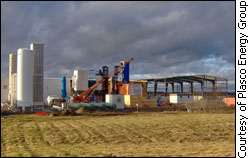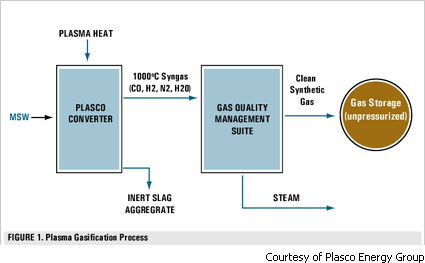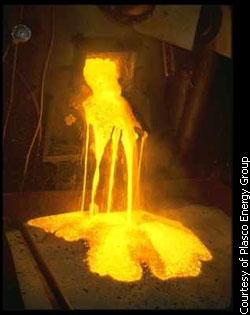
|
|
Plasma gasification vapourizes non-recyclable garbage diverted from landfills at temperatures well above 8000 Celsuis and converts it into a usable and sustainable energy source. Although plasma technology has been used in many different forms for decades, it has never been used in Canada to dispose of municipal waste. Plasco Energy Group, a private Canadian company owned by local-entrepreneur Rod Bryden, is hoping to change that.
Plasco is currently building a pilot gasification plant in Ottawa, to prove gasification is the greenest and most profitable way to dump the city’s trash. Although the project is being met with some skepticism, Plasco’s head scientist, Andreas Tsangaris, says he’s confident the City of Ottawa will see the benefits to this kind of disposal system. “We have done extensive research since the mid-80s and developed a process that will do the work, we are sure,” he says. “We have proven that the environmental acceptability is superior to anything else, and now we are proving the economic value.” The company says the plant should be up and running in the spring of 2007. When it is, a portion of Ottawa’s waste will be shipped to the facility instead of to the Trail Road landfill, the city’s main dumping grounds. When life hands you garbage, make energy! To squeeze energy from garbage, trash is shredded and chopped into smaller pieces, then fed into a chamber where the actual gasification takes place. In this chamber, a strong electrical current is passed between two electrodes. When the electrical current is exposed to air, it creates an electrically charged gas called plasma. If the electrical charge is high enough, the plasma can reach such high temperatures that it can melt anything in its path. With the amount of electricity that is passed between the electrodes within the chamber, the plasma can generate enough heat to essentially disintegrate the garbage inside.
Unlike burning, which may still leave small pieces of the garbage untouched, gasifying the garbage breaks it down to its most basic form. Think of the pieces of garbage as a long chain. Heating the chain with the plasma method breaks it down to its individual links, to the point where it can’t be broken down any further. After the treated garbage cools, what is left behind is a solid material called “slag” and a synthetic gas, appropriately called “syngas”, which is purified and used to create electrical energy. Tsangaris says the gas produced by heating the garbage can be collected and safely used as energy in the same way people use natural gas. The leftover “slag” is a glassy byproduct that Tsangaris says is “cleaner than the bottles you drink your soda in.” He says that the company has high hopes of selling the slag as an aggregate in concrete or cement, or as road-fill. “The material does not even need to go into landfills anymore, it will be used to build roads or to put in concrete, things like that,” he says. “It has similar properties to materials that have been used in concrete before, so we are in the process of establishing that right now.” When it’s fully operational, the plant will be able to process about 75 tonnes of garbage each day, just under one quarter of the city’s daily waste production. The company predicts it will produce enough energy to power about 3,600 homes around Ottawa. Plasco will keep some of the gas produced to power the plasma gasification system, but the rest will be sold to Hydro Ottawa. The good … The energy isn’t the only benefit to this new kind of garbage disposal. Experts say it’s also a lot cleaner than other forms of waste management. Dr. Chris Snoek of Natural Resources Canada says that getting rid of garbage in this manner is a lot better than just burning it or throwing it into landfills. Burning garbage could still put harmful emissions into the air if it’s not done properly, and toxins from garbage thrown in landfills could easily make their way into the water systems, he says, making both methods less than ideal. “Garbage is going to be here to stay, so we have to find a good solution. And even though it would be better to live without garbage, if we do have it, gasification is not the worst idea in my books,” he says. “And nobody wants to live around a landfill.”
He also points out that when the garbage is gasified there is no methane produced, unlike landfills which produce lots of it. “Methane is a far worse greenhouse gas than carbon dioxide,” he says. “So if you gasify your garbage then you won’t see any methane. You would see carbon dioxide, yes, but you wouldn’t see methane. So there’s an advantage there.” Tsangaris says the plant will be producing very few emissions. In fact, he says the only sources of emissions are the turbines that would power the process, and no harmful pollutants or gases would be released from the garbage at all. “We don’t produce any pollutants, whether it be gaseous or solid, and at the same time we produce clean energy,” Tsangaris says. The fact that the plant produces no pollutants is a big part of its appeal, and John Steele from the Ontario Ministry of the Environment says it’s part of the reason Plasco’s pilot project was approved by the city. “That sort of approval will only be granted if you can guarantee to the ministry that you can meet the emissions requirements of our legislation and our policies,” he says. “So in the case of air, the Environmental Protection Act indicates that at your plant boundaries you are only allowed to put out a certain amount of contaminants. So it depends what you are going to put out. If we’re satisfied with what we read from them then they get a certificate of approval.” … and the bad But there are still a few disadvantages to using plasma gasification to get rid of garbage. First, since this sort of system has never been tried before in Canada it’s hard to say whether or not it will actually work on a large scale. However, Tsangaris says that Plasco has a test facility in Spain that is identical to the one being built in Ottawa, and so far the technology has been working as expected. Even so, some Ottawa citizens are concerned about using plasma gasification for waste disposal and are worried about what will happen to different household materials should they make it into the gasification plant.
“There are people who are very concerned that there are things like ordinary household batteries going into the fire and cadmium and all sorts of nasty metals are coming out of the chimney,” says Snoek. “But these things are very easily measured.” Snoek also says that the population could be encouraged to separate their garbage before throwing it out, just to make sure things like batteries would not be going into the gasification plants. Cost is also a big issue. Construction, maintenance and operating costs can add up quickly, and it may not be economically feasible for some communities to start up this sort of program. In Ottawa’s case, however, Tsangaris says cost is a non-issue. “We’re putting our money where our mouth is, so to speak. The whole facility’s financed mostly by [Plasco’s] money,” he says. “The cost to the municipality would be less than if they were putting it in landfills.” A dream come true? So for Ottawa, this new form of waste management seems almost too good to be true. But Snoek believes that if Plasco proves the process works, it could become the main source of waste disposal for the city. “I think definitely Ottawa should move towards it,” he says. “The garbage is there, you have to deal with it, and one has to find the most benign and profitable and most useful way possible.”
|
|
|


